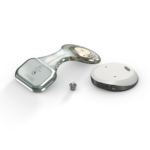Since 2011, Cochlear™ and ReSound have collaborated in the Smart Hearing Alliance to provide hearing solutions for people with all types of hearing loss. Whether the need is for hearing aids, hearing implants, or a combination of the two, our solutions work together seamlessly. Through the Smart Hearing Alliance, we are committed to improving bimodal hearing care in partnership with you. Our solutions are evidence-based and designed to help you effectively meet the changing needs of your patients over time.
For many people, a bimodal hearing solution with a cochlear implant (CI) on one ear and a hearing aid (HA) on the other is the combination that provides them with their best hearing.1-7
Introducing bimodal control in the Nucleus® Smart App
Every day your bimodal patients are exposed to a range of different hearing environments. If they find themselves in a new environment and want to change their volume, program, or manage a True Wireless™ accessory, controlling two hearing devices requires careful attention to how their hearing devices are connected to and controlled by their Bluetooth® connected device. As a result, patients may choose to only adjust one hearing device.
To help your patients get the most out of their hearing in everyday moments, Cochlear has introduced bimodal control in the Nucleus Smart App. Bimodal control is designed to help your patients quickly and easily manage their compatible ReSound ONE™ or ReSound OMNIA™ hearing aid and compatible Cochlear Sound Processor* in the same app. When a patient chooses to set up bimodal control within the Nucleus Smart App, they will be able to make volume adjustments, change programs, and manage wireless accessories for both devices. Additional device features will continue to be available through the Nucleus Smart App and the ReSound Smart 3D™ app, including Find my Hearing Aid.
With bimodal control in the Nucleus Smart App, it’s never been easier or more convenient for your bimodal patients to make common adjustments to help achieve their best possible hearing experience.
Because when both the hearing aid and CI sound processor are delivering the best possible sound, known bimodal benefits are optimized.
Cochlear’s Bimodal Hearing Evidence Summary summarizes some key insights from research studies about the benefits of bimodal hearing solutions for adult CI users.
Bimodal hearing benefits for speech understanding in quiet and noise
The studies here show that for unilateral cochlear implant users with residual hearing in the non-implanted ear, access to these benefits is possible by fitting a hearing aid to that ear. In addition to hearing better in noise, bimodal hearing is also shown to improve the range and quality of the sound being heard.
- Kelsall D, Lupo J, Biever A. Longitudinal outcomes of cochlear implantation and bimodal hearing in a large group of adults: A multicenter clinical study. 2021 Am J Otolaryngol. 2021 Jan-Feb; 42(1):102773. doi: 10.1016/j.amjoto.2020.102773 Epub 2020 Oct 22. PMID: 33161258.
- Hoppe U, Hocke T, Digeser F. Bimodal benefit for cochlear implant listeners with different grades of hearing loss in the opposite ear. Acta Oto-Laryngol 2018, 138, 713–721.
- Gifford RH, Dorman MF. Bimodal hearing or bilateral cochlear implants? Ask the patient. Ear Hear. 2019 ; 40(3): 501–516.
Bimodal hearing benefits for quality of life
The studies here assess quality of life outcomes using a variety of established self-report scales. They examine the overall well-being of participants in several health-domains including daily hearing function and its impact on everyday life. The evidence shows on average, statistically significant benefits for bimodal hearing users on quality-of-life measures compared to their daily listening condition when using one or two hearing aids or a cochlear implant alone.
- Buchman CA, Herzog JA, McJunkin JL, et al. Assessment of speech understanding after cochlear implantation in adult hearing aid users: A nonrandomized controlled trial. JAMA Otolaryngol Head Neck Surg. Published online August 27, 2020. doi:10.1001/jamaoto.2020.1584.
- Sanhueza I, Manrique-Huarte R, Calavia D, Huarte A, Manrique M. Hearing impairment and quality of life in adults with asymmetric hearing loss: Benefits of bimodal stimulation. J Int Adv Otol. 2019 Apr;15(1):62-69. doi: 10.5152/iao.2019.6224. PMID: 31058597; PMCID: PMC6483429.
- Sladen DP, Carlson ML, Dowling BP, Olund AP, DeJong MD, Breneman A, Hollander S, Beatty CW, Neff BA, Driscoll CL. Cochlear implantation in adults with asymmetric hearing loss: Speech recognition in quiet and in noise, and health related quality of life. Otol Neurotol. 2018 Jun;39(5):576-581. doi: 10.1097/MAO.0000000000001763. PMID: 29683995.
Bimodal hearing delivers functional hearing benefits and improved satisfaction with daily hearing
The evidence shows that a significantly higher number of bimodal hearing users report being satisfied or very satisfied with their hearing ability during a variety of daily listening activities, compared to their satisfaction when using hearing aids. In addition to reduced listening fatigue, the studies below also demonstrated significant and clinically important improvements for hearing speech in daily life, quality of sound, and localization of sounds for bimodal hearing users, compared to when they used one or two hearing aids.
- Plant K, van Hoesel R, McDermott H, Dawson P, Cowan R. Influence of contralateral acoustic hearing on adult bimodal outcomes after cochlear implantation. Int J Audiol. 2016 Aug;55(8):472-82. doi: 10.1080/14992027.2016.1178857. Epub 2016 May 23. PMID: 27216386.
- Neuman AC, Waltzman SB, Shapiro WH, Neukam JD, Zeman AM, Svirsky MA. Self-Reported Usage, Functional Benefit, and Audiologic Characteristics of Cochlear Implant Patients Who Use a Contralateral Hearing Aid. Trends Hear. 2017 Jan;21:2331216517699530. doi: 10.1177/2331216517699530. PMID: 28351216; PMCID: PMC5435367.
- Lupo JE, Biever A, Kelsall DC. Comprehensive hearing aid assessment in adults with bilateral severe-profound sensorineural hearing loss who present for Cochlear implant evaluation. Am J Otolaryngol. 2020 Mar-Apr;41(2):102300. doi: 10.1016/j.amjoto.2019.102300. Epub 2019 Sep 11. PMID: 31761407.
Bimodal hearing benefits from direct audio streaming
The studies here demonstrate the advantages of direct audio streaming for bimodal users when compared to using a cochlear implant alone. Results indicate wireless audio streaming accessories may offer further improvement in speech understanding in noisy situations when used with bimodal hearing compared to the cochlear implant alone. Performance with direct audio streaming of phone calls to bimodal devices was also shown to improve communication ability on the phone compared when using only an implant.
- Vroegop JL, Dingemanse JG, Homans NC, Goedegebure A. Evaluation of a wireless remote microphone in bimodal cochlear implant recipients. Int J Audiol. 2017 Sep;56(9):643-649. doi: 10.1080/14992027.2017.1308565. Epub 2017 Apr 10. PMID: 28395552.
- Wolfe J, Morais M, Schafer E. Speech recognition of bimodal cochlear implant recipients using a wireless audio streaming accessory for the telephone. Otol Neurotol. 2016 Feb;37(2):e20-5. doi: 10.1097/MAO.0000000000000903. PMID: 26756151.
Bimodal hearing benefits for sound localization
In these studies, the degree of binaural benefit for an individual in terms of sound localization is reported. The benefits obtained may be influenced by the level of hearing in each ear and the resulting degree of asymmetry between the ears.
- Firszt JB, Reeder RM, Holden LK, Dwyer NY; Asymmetric hearing study team. Results in adult cochlear implant recipients with varied asymmetric hearing: A prospective longitudinal study of speech recognition, localization, and participant report. Ear Hear. 2018 Sep/Oct;39(5):845-862. doi: 10.1097/AUD.0000000000000548. PMID: 29373326; PMCID: PMC6103899.
- Jang JH, Lee JH, Chang SO, Oh SH. Effect of aided hearing in the nonimplanted ear on bimodal hearing. Otol Neurotol. 2014;35: e270-6.
Bimodal hearing benefits for music appreciation
The studies below found that when listening to music, on average bimodal hearing users achieved better hearing performance when wideband frequency amplification was used in the hearing aid compared to narrower frequency bands. Furthermore, recognition of musical instruments was superior with bimodal configuration compared with using either a cochlear implant or hearing aid alone.
- D’Onofrio KL and Gifford RH. Bimodal benefit for music perception: Effect of acoustic bandwidth. JSLH; 2021, 64: 1341–1353.
- Duret S, Bigand E, Guigou C, Marty N, Lalitte P, Bozorg Grayeli A. Participation of Acoustic and Electric Hearing in Perceiving Musical Sounds. Front Neurosci. 2021 May 5;15:558421. doi: 10.3389/fnins.2021.558421. PMID: 34025335; PMCID: PMC8131516.
- Shukor NFA, Lee J, Seo YJ, Han W. Efficacy of Music Training in Hearing Aid and Cochlear Implant Users: A Systematic Review and Meta-Analysis. Clin Exp Otorhinolaryngol. 2021 Feb;14(1):15-28. doi: 10.21053/ceo.2020.00101. Epub 2020 Jul 11. PMID: 32646208; PMCID: PMC7904420.
* For compatibility information and devices visit www.cochlear.com/compatibility and for more information regarding the compatibility of ReSound hearing aids, visit resound.com/compatibility
For more information regarding ReSound hearing aids, visit pro.resound.com.
The Bluetooth® word mark and logos are registered trademarks owned by Bluetooth SIG, Inc. and any use of such marks by Cochlear is under license.
The Cochlear Nucleus Smart App is available on App Store and Google Play. For compatibility information visitwww.cochlear.com/compatibility.
1. Farinetti A, Roman S, Mancini J, et al. Quality of life in bimodal hearing users (unilateral cochlear implants and contralateral hearing aids). Eur Arch Otorhinolaryngol (2015 Nov); 272, 3209–3215.
2. Ching TY, Incerti P, Hill M. Binaural benefi ts for adults who use hearing aids and cochlear implants in opposite ears. Ear Hear (2004 Feb); 25, 9–21.
3. Potts LG, Skinner MW, Litovsky RA., et al. Recognition and localization of speech by adult cochlear implant recipients wearing a digital hearing aid in the nonimplanted ear (bimodal hearing). J Am Acad Audiol (2009 Jun); 20, 353–373.
4. Morera C, Cavalle L, Manrique M, et al. Contralateral hearing aid use in cochlear implanted patients: Multicenter study of bimodal benefi t. Acta Otolaryngol (2012 Jun); 132, 1084–1094.
5. Giff ord RH, Dorman MF, McKarns SA, Spahr AJ. Combined electric and contralateral acoustic hearing: Word and sentence recognition with bimodal hearing. Journal of Speech, Language, and Hearing Research. (2007 Aug) 1;50(4):835-43.
6. Sucher CM, McDermott HJ. Bimodal stimulation: benefi ts for music perception and sound quality. Cochlear Implants International. (2009 Jan); 1;10(S1):96-9.
7. Buchman CA, Herzog JA, McJunkin JL, et al. Assessment of Speech Understanding After Cochlear Implantation in Adult Hearing Aid Users: A Nonrandomized Controlled Trial. JAMA Otolaryngol Head Neck Surg. Published online (2020 Aug). doi:10.1001/jamaoto.2020.1584


